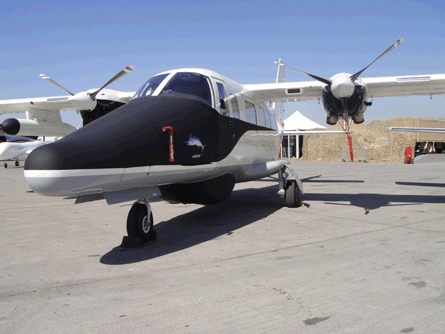Compared with the Ferrari-inspired grace of the Piaggio P180 Avanti II twin-pusher, there is less to delight the senses with the Vulcanair P68, Italy's other home-grown civil aircraft.
But, then again, the high-wing, versatile piston-twin from Naples - while incorporating enough Italian genes to turn the odd head - was never designed for the fashion stakes. The P68's markets include surveillance - the Observer version comes with full Plexiglass nose - and those operating in remote regions in sectors such as mining.
"It is ideal for anywhere there are no roads and you need a rugged, reliable, two-engine aircraft that is easy to maintain," says director of sales Remo de Feo, part of the family that in 1998 bought the Naples airport site and assets of the P68's original manufacturer - the one-time Alenia-owned Partenavia - with a view to updating the old designs and establishing a new niche brand in general aviation (Vulcanair is named after the nearby Vesuvius volcano).
 |
|---|
© VulcanairVulcanair has high hopes for the A-Viator, a turboprop-powered stretch of the P68 |
Success did not land overnight. After purchasing the remnants of the business with the obligation to support the existing fleet of P68s - and its predecessors the P64 and P66 - it took until 2001 for Vulcanair to commit to relaunching production. With the reputation of its long-ailing predecessor badly tarnished, the scale of the turnaround was clear. "We started contacting customers and while everyone loved the aircraft they hated the support. They were throwing their shoes at us," recalls de Feo.
However, by building slowly and introducing updates such as new avionics, Vulcanair has managed to re-establish the all-aluminium aircraft in the market. Over the past eight years, the company has delivered about 80 P68s, split equally between the Observer and the conventional P68C. Prices start at around $760,000 and the company is producing a little over one aircraft a month, although de Feo says there is capacity to build around 30 a year.
A potentially exciting development is the A-Viator, an 11-seat turboprop-powered stretch of the P68. The original version was certificated in the late 1980s by Partenavia but had little success in the market. Vulcanair is introducing a glass cockpit and autopilot and has begun manufacturing the first airframe with an aim to have the new variant certificated by the end of next year.
Although it has no firm orders, de Feo says there has been a "lot of interest" from South-East Asia and Australasia in the Rolls-Royce 250B17C-powered utility, prices for which will start at $2.3 million.
The aircraft is unpressurised, but de Feo says the large side door makes it highly suitable for the cargo market as a replacement for ageing types such as the Cessna 402.
"We have also discovered the irregular military market, surveillance, troop transport and logistical support, where you need a reliable twin-engine aircraft," says de Feo, who plans to display the A-Viator at Australia's Avalon air show in March and follow that with demonstrations in Papua New Guinea, Indonesia, Malaysia and India.
Vulcanair aims to manufacture three A-Viators in 2011 and "we are confident we can sell at least 10 in 2012", adds de Feo.
Vulcanair's 60,000m2 (645,000ft2) premises, with their two storeys of offices and large hangar next to Naples' Capodichino airport, still have the feel of the legacy business which in the 1960s to 1980s was one of Europe's biggest GA manufacturers. The new owners' ambitions in the market may be relatively modest, but if the A-Viator can claim a niche alongside the P68, Vulcanair will firmly establish its place in the latest generation of European GA manufacturers.
Source: Flight International
















